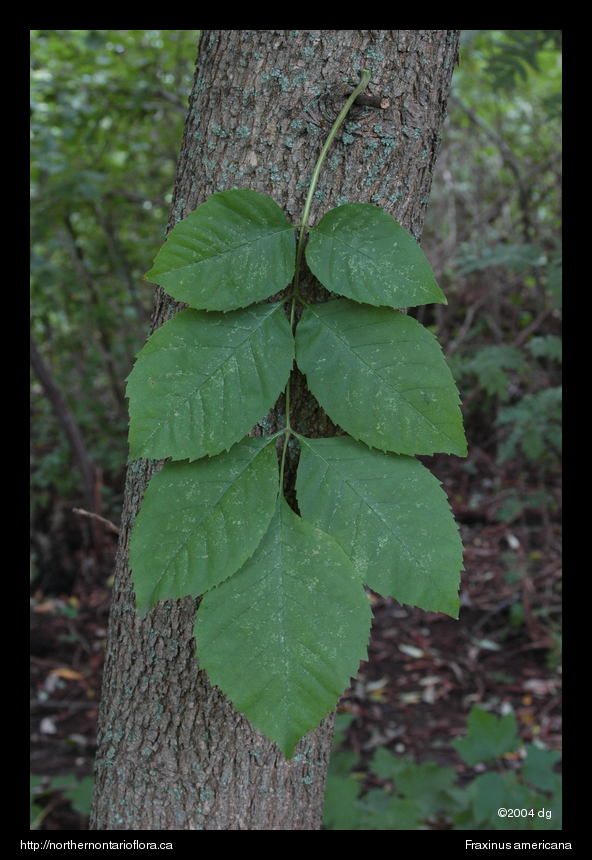
|
Northern Ontario Plant Database 
Plant DescriptionFraxinus americana L.En: white ash, American ash, cane ash
Oleaceae (Olive Family) The Genus Fraxinus: Ontario's native ash species grow to be relatively tall trees. All species have opposite, deciduous, pinnately compound leaves with 5–11 leaflets, the terminal leaflet is stalked. Flowers are mostly unisexual, but bisexual (perfect) flowers may occur in the same inflorescence as unisexual flowers; flowers are borne in clusters (panicles) in the axils of the previous year's leaves. Petals are lacking; sepals are present in some species, but absent in black ash; stamens 2; the single pistil develops into a flat, winged samara. General: A medium-size to tall tree, to 30 m tall. Bark, grayish-brown, furrowed; the stout twigs smooth (glabrous), buds brown to rusty-brown; the terminal bud low-conical; lateral buds dome-shaped, their sides and base surrounded by the U-shaped or deeply notched leaf scars. The first set of lateral buds is situated very close to the terminal bud. Leaves: Opposite, pinnately compound, usually with 7 stalked leaflets (sometimes 5 or 9). Leaflets oblong, ovate, or obovate, 5–15 cm long; glabrous, green above, obviously whitened beneath, sometimes hairy along the veins; base of lateral leaflets rounded, apex sharply pointed (acuminate), margins entire to finely toothed (serrate); lower leaflets are smaller than the upper leaflets; stalks of the leaflets (petiolules) to 1.5 cm long, not winged; the stalk of the terminal leaflet about 4 times the length of the lateral leaflet stalks. Leaves turn bronze, purplish, or reddish-brown in autumn. Flowers: Unisexual, with male and female flowers on separate trees (plants dioecious); male flowers borne in dense clusters; female flowers borne in feathery, open panicles; sepals are very small, but petals are lacking. Flowers bloom before or with the emergence of the leaves. Fruit: A winged samara, linear to narrowly oblanceolate, 2.5–5 cm long, 4–7 mm broad, the wing 2–3 times the length of the enclosed seed. The wing narrowing towards and attached only at the top of the seed. Habitat and Range: Rich, moist, well-drained soils, upland forests; often growing with sugar maple. White ash is a temperate, eastern North American species found throughout southern and eastern Ontario, it extends north to the southern Algoma District. Internet Images: The Fraxinus americana webpage, from the Trees of Wisconsin website. Click on the smaller images to view larger, more detailed photos. The Fraxinus americana webpage from the Virginia Tech Dendrology website, and the Fraxinus americana webpage from the USDA Silvics of North America website. Similar Species: The leaves of red ash, Fraxinus pensylvanica, are most similar to white ash, with both species usually having leaves with 7 leaflets (see comparison chart below). However, the leaf scars can be used to clearly differentiate these two species from one another. White ash has deeply notched or U-shaped leaf scars, while red ash has larger, oval to hemispherical leaf scars
Other species that may be confused with ash are Acer negundo, the Manitoba maple or box elder, and Juglans nigra, the black walnut. Both webpages below are from the Trees of Wisconsin website. Click on the smaller images to view larger, more detailed photos. The Manitoba maple, Acer negundo, is also known as the ash-leaf maple due to its opposite, pinnately compound leaves, which can be differentiated from those of ash by the 5 (rarely 7) lobed leaflets. Other differences include the shape of the leaf scars and the fruit. Like other maples, Acer negundo has narrow U- or V-shaped leaf scars with 3 bundle trace scars and a pair of winged samara, while ashes have hemispherical or thicker U-shaped leaf scars with numerous bundle trace scars and narrow unpaired samaras. At first glance, Juglans nigra, the black walnut, may be confused with an ash also. It has pinnately compound leaves, but with more leaflets, 11– 15, and a large globose fruit (a tryma, which is a drupe with a dehiscent husk). The twigs of walnuts have chambered pith, while ashes have twigs with solid pith. The Virginia Dendrology website also has a webpage on Juglans nigra. Back to species list |
||||||||||||||||||||||||||||||||||||||||||||||||||||||||








